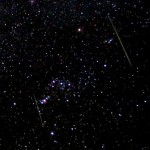Over the next few days the Perseid meteor shower will peak. As the most reliable shower each year this is also the most viewed meteor shower. Plentiful shooting stars combined with warm summer evenings makes this shower the easiest and most comfortable to view across much of the northern hemisphere. Quite a difference from the other reliable showers such as the Leonids and Quadrantids, that occur in November and January. Consider a warm summer night under a dark sky full of stars, a picnic blanket, relaxing while shooting stars streak across the sky. What could be better?

A typical Perseid shower will produce up to 60-100 meteors an hour, what regular meteor observers would call 60-100ZHR. This is what a typical observer would see given a dark sky and good conditions with the shower radiant at zenith, a metric called zenithal hourly rate or ZHR. You can estimate this rate by counting the meteors seen in a shorter period. If you count the meteors that you see for ten minutes and multiply by 6 you would have a reasonable estimate of ZHR. As the rate of meteor arrival is irregular it is necessary to count for ten minutes or more to achieve a decent average rate. Conditions such as light pollution or clouds will result in some faint meteors being missed and a lower count.
This year viewing conditions are excellent. The new moon occurs on the 14th, little to no moonlight will be present to spoil the show. The constellation Perseus and the shower radiant will rise around local midnight, making beginning the show each evening. Unfortunately the northern position of the radiant prevents observers in the southern hemisphere from seeing much of this shower.
The traditional Perseid peak will occur on August 13th at 0630UT, thus would be the evening of August 12th for viewers in the islands. As the Perseid peak is a long and broad peak good activity can be seen for a week or more either side of this peak. Even the timing of the peak is uncertain and could be several hours either side of 0630UT. While the night of the 12th is favored for Pacific observers, good meteor activity makes the observing schedule somewhat flexible. As discussed in the excerpt below, there is the possibility of substantial activity in the hours around 1830UT on August 12th, or the 0830HST on the morning of August 12th, making the pre-dawn hours of the 12th possibly productive for Hawaiian observers.
The Perseids produced strong activity from an unexpected primary maximum throughout the 1990s, associated with the perihelion passage of their parent comet, 109P/Swift-Tuttle, in 1992. The comet’s orbital period is about 130 years. Further enhanced activity ahead of the usual maximum was last seen in 2004.
Recent IMO observations (see HMO p. 145) found the timing of the mean or ‘traditional’ broad maximum varied between λ⊙ ∼ 139.8° to 140.3°, equivalent to 2015 August 13, 01h30m to 14h00m UT. J´er´emie Vaubaillon anticipates from theoretical modelling that the dust trail from the comet’s 1862 return should pass closest to the Earth (the separation is about 0.00053 astronomical units, only 80 000 km or so) at 18h39m UT on August 12, although the activity levels are uncertain. Enhanced rates, if they happen at all, may persist for several hours around this potential peak. Plus of course, neither this prediction, nor the nodal crossing time given in the box above, are guarantees of what will occur!
New Moon on August 14 means whatever happens, dark skies will prevail for checking on it. Sites at mid-northern latitudes are more favourable for Perseid observing, as from here, the shower’s radiant can be usefully observed from 22h–23h local time onwards, gaining altitude throughout the night. The August 12 peak time especially favours Asian longitudes, while the August 13 near-nodal part of the ‘traditional’ maximum interval would be best-viewed from North American sites, assuming either takes place when expected. All forms of observing can be carried out on the shower, though regrettably, it cannot be properly viewed from most of the southern hemisphere. – IMO 2015 Meteor Calendar
Watching meteors requires no more equipment than your eyes and a dark sky, and can be enjoyable for just about anyone. A good meteor shower is a great excuse to get out under a dark sky and enjoy the stars. Conditions should be quite good, why not make a point to watch the Perseids this year?


Lets hope Hilda will let us see it
Hilda should not be here until Thursday, maybe late Weds. This is after the peak, get out to observe Tuesday?